Ensuring Customer Satisfaction: 20 Templates for Effective Follow-up Letters in Complaint Resolution
Welcome to Complaint Follow-up Letters! We specialize in providing a wide selection of professionally designed follow-up letter templates exclusively created for complaint resolution. Our templates are designed to help you address and resolve customer concerns efficiently and effectively. Whether you are a customer service representative, business owner, or individual seeking to resolve a complaint, our templates cover various industries and offer the right format and tone to convey empathy and commitment to resolving issues. Choose Complaint Follow-up Letters to enhance your customer service and transform negative experiences into positive ones.
Tips for Writing an Effective Complaint Follow-up Letter
- Maintain a professional and respectful tone: Keep your tone polite and professional throughout the letter. Avoid using aggressive or offensive language, as it may hinder the resolution process.
- Clearly state the purpose of your letter: Start your letter by clearly stating that it is a follow-up to a previous complaint. Mention the date and details of your initial complaint to provide context.
- Structure your letter effectively: Organize your letter into paragraphs with clear headings to ensure readability. Use concise and focused paragraphs to address specific points or concerns.
- Provide specific details: Include relevant details such as dates, order numbers, and names of customer service representatives involved in your complaint. This helps the recipient identify and address your concerns more effectively.
- State the impact on you: Explain how the issue or unresolved complaint has affected you, whether financially, emotionally, or otherwise. Share any inconvenience or distress caused to emphasize the importance of resolving the matter.
- Be specific about your desired resolution: Clearly state what you expect as a resolution to your complaint. Whether it’s a refund, replacement, apology, or compensation, specify your preferred outcome to guide the recipient in addressing your concerns.
- Include supporting evidence: If you have any relevant documents or evidence related to your complaint, such as receipts, photographs, or email correspondences, attach copies to strengthen your case and provide clarity.
- Set a reasonable deadline: Request a reasonable timeline for the recipient to respond and resolve the complaint. This demonstrates your seriousness and helps ensure a timely resolution.
- Follow up with contact information: Provide your contact details, including your phone number and email address, so the recipient can easily reach out to you for further communication or clarification.
- Proofread and edit: Before sending your letter, carefully proofread it to check for any grammatical errors or typos. Ensure that your message is clear, and concise, and effectively conveys your concerns.
The Role of Follow-Up
Follow-up matters because it shows your dedication to addressing the complaint and finding a satisfactory resolution. It ensures that the complaint doesn’t get overlooked or forgotten and allows you to maintain a positive relationship with the complainant. Following up not only demonstrates your professionalism and commitment to customer satisfaction but also provides an opportunity to gather additional information, offer clarification or apologies, and keep the complainant informed about the progress of their case. By actively following up, you show empathy toward the complainant’s concerns, reinforce their trust in your brand or organization, and increase the likelihood of reaching a mutually agreeable solution.
- Demonstrates commitment to resolving the complaint.
- Maintains open lines of communication with the complainant.
- This prevents the complaint from being overlooked or forgotten.
- Shows professionalism and dedication to customer satisfaction.
- Provides an opportunity to gather additional information.
- Offers clarification or apologies if necessary.
- Keeps the complainant informed about the progress of their case.
- Reinforces trust in your brand or organization.
- Increases the likelihood of reaching a mutually agreeable solution.
- Preserves and strengthens the relationship with the complainant.
#1: Customer Service Complaint Follow-up Letter:
This letter is used to follow up on a complaint regarding poor customer service received from a company representative. The Customer Service Complaint Follow-up Letter is used to address a complaint regarding an unsatisfactory customer service experience from a company representative. This letter serves the purpose of seeking a resolution and expressing concerns about the quality of service provided. It allows the customer to communicate their dissatisfaction, provide details of the incident, and request appropriate actions to be taken by the company to address the issue.
The letter aims to encourage prompt attention to the complaint and ensure that future customer service interactions meet the expected standards of professionalism and customer satisfaction.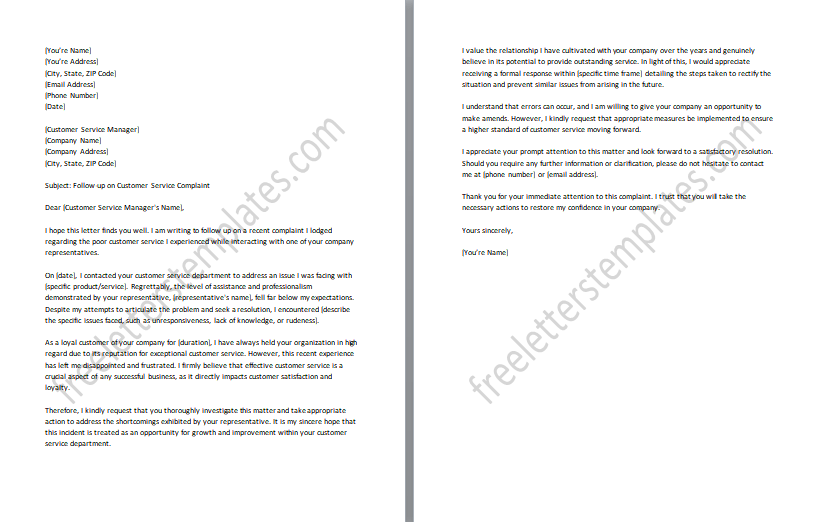
#2: Product Defect Complaint Follow-up Letter:
This letter is sent to follow up on a complaint about a defective product and to request a resolution or replacement. The Product Defect Complaint Follow-up Letter is used to address a complaint regarding a defective product and to request a resolution or replacement. This letter serves the purpose of following up on a previous complaint and expressing the customer’s dissatisfaction with the product’s quality or functionality.
It provides an opportunity for the customer to provide additional details about the defect, such as its impact or any safety concerns, and to request a suitable resolution, which may include a replacement of the defective product or a refund. The letter aims to emphasize the importance of product quality and customer satisfaction while seeking a fair and satisfactory resolution from the company.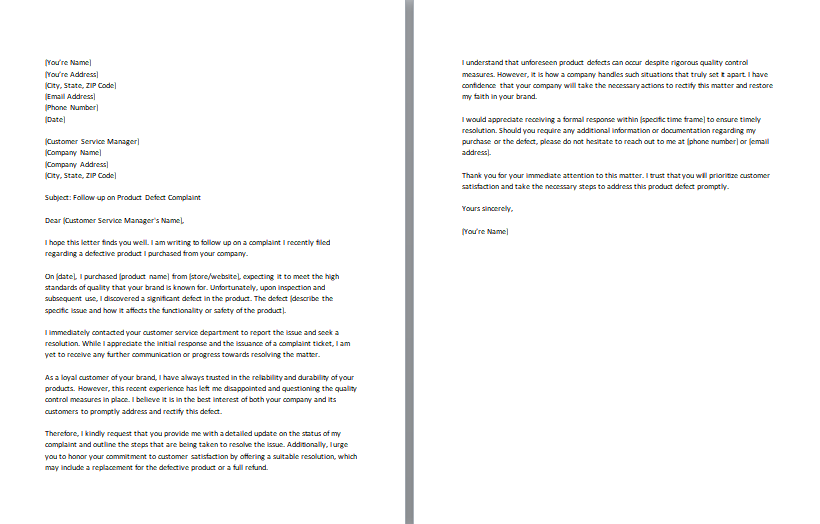
#3: Billing Error Complaint Follow-up Letter:
This letter is used to follow up on a complaint regarding an incorrect or overcharged bill, seeking clarification and resolution. The Billing Error Complaint Follow-up Letter is a means for customers to address their concerns about an incorrect or overcharged bill and seek clarification and resolution. This letter serves as a follow-up to a previous complaint, expressing the customer’s dissatisfaction with the billing discrepancy. It provides an opportunity for the customer to provide further details about the error, such as specific charges or discrepancies they have identified, and request a clear explanation or correction from the company. The letter’s purpose is to highlight the importance of accurate billing and fair treatment of customers while seeking a prompt and satisfactory resolution to the billing error.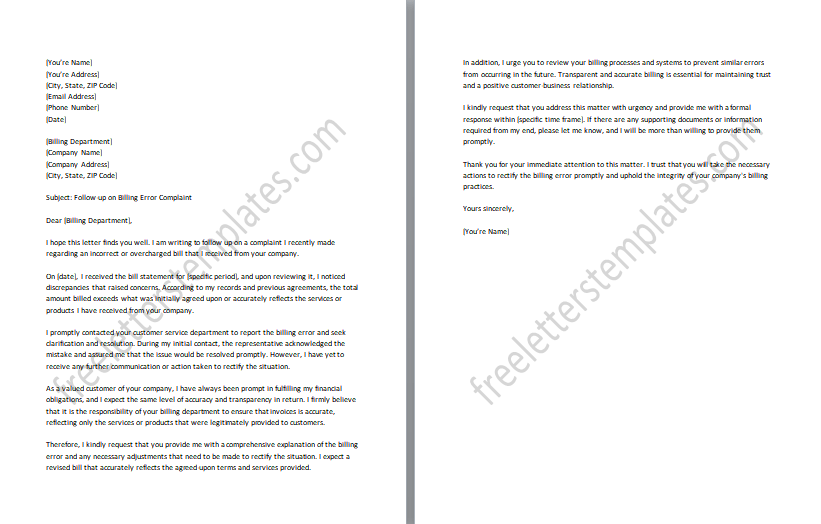
#4: Delayed Delivery Complaint Follow-up Letter:
This letter is sent to follow up on a complaint about delayed delivery and to request updates or compensation if necessary. The Delayed Delivery Complaint Follow-up Letter allows customers to express their frustration regarding a delivery that didn’t arrive on time and request updates or compensation if necessary. It’s a way for customers to follow up on their initial complaint and explain the inconvenience caused by the delay. The main objective of this letter is to highlight the importance of reliable and timely deliveries while aiming for a quick resolution and maintaining a positive relationship with the company. By using this letter, customers can effectively communicate their concerns and work together with the company to find a fair and satisfactory solution to the delayed delivery issue.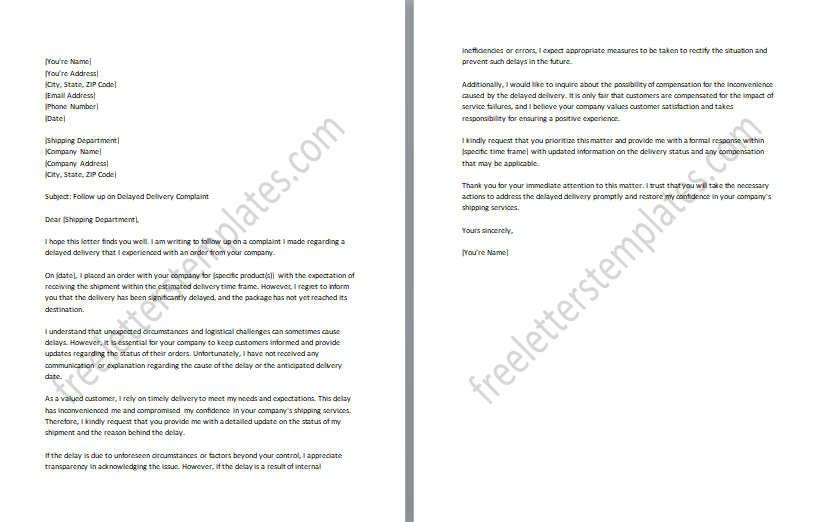
#5: Quality Assurance Complaint Follow-up Letter:
This letter is used to follow up on a complaint about a product or service not meeting expected quality standards and to seek a resolution. The Quality Assurance Complaint Follow-up Letter is a way for customers to express their disappointment when a product or service fails to meet their expectations in terms of quality. In this letter, customers have the opportunity to provide specific details about the problems they experienced, such as defects, poor workmanship, or underwhelming performance. They can also request a suitable solution or remedy from the company. By using this letter, customers can establish a constructive line of communication, express their expectations, and seek appropriate actions to address the quality assurance concerns they have encountered.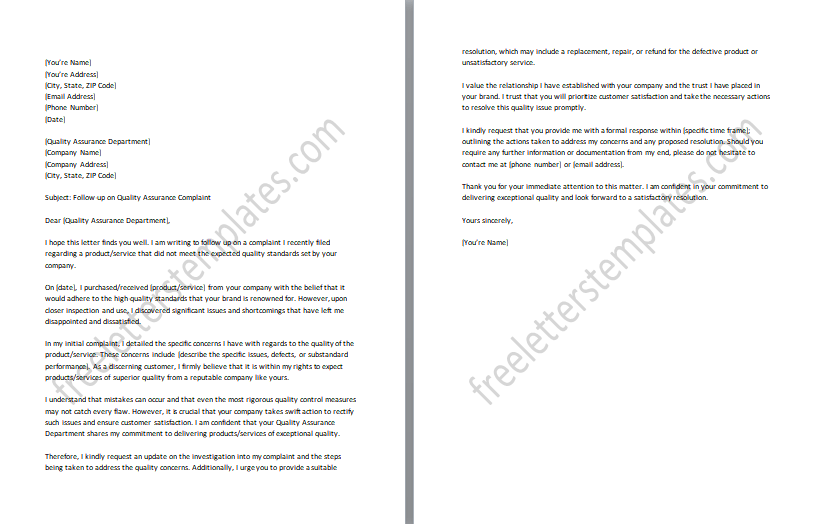
#6: Warranty Claim Complaint Follow-up Letter:
This letter is sent to follow up on a complaint regarding a denied or unresolved warranty claim, seeking reconsideration or a solution. The Warranty Claim Complaint Follow-up Letter is a means for customers to address their dissatisfaction with a denied or unresolved warranty claim and request a reconsideration or solution. This letter serves as a follow-up to a previous complaint, expressing the customer’s frustration and disappointment with the outcome of their warranty claim. The letter’s purpose is to emphasize the importance of honoring warranty agreements and providing proper customer support while seeking a fair and satisfactory resolution to the warranty claim. It aims to maintain a positive customer-business relationship by establishing open communication and working towards finding a mutually beneficial outcome.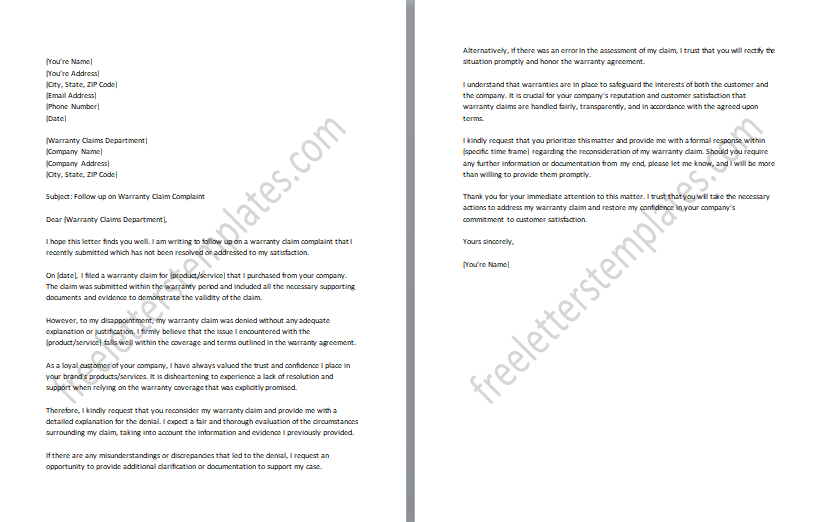
#7: Refund Request Complaint Follow-up Letter:
This letter is used to follow up on a complaint about a refund request that has not been processed, urging the company to address the issue promptly. The Refund Request Complaint Follow-up Letter is a way for customers to address their frustration when a refund request has not been processed and urge the company to address the issue promptly. This letter serves as a follow-up to a previous complaint, expressing the customer’s dissatisfaction and inconvenience caused by the delay or non-processing of their refund. The letter’s purpose is to convey the customer’s expectation for a prompt resolution, requesting the company take immediate action to process the refund and rectify any delays or errors. It aims to maintain a good customer-business relationship by encouraging effective communication and seeking a fair and timely resolution to the refund request issue.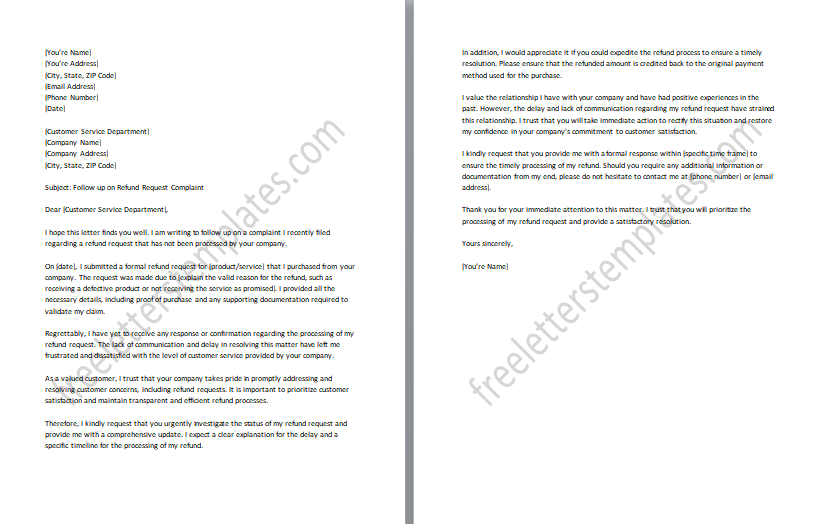
#8: Contract Dispute Complaint Follow-up Letter:
This letter is sent to follow up on a complaint related to a contract dispute, seeking resolution or legal action if necessary. The Contract Dispute Complaint Follow-up Letter is a means for customers to address their concerns regarding a contract dispute and seek resolution or legal action if necessary. This letter serves as a follow-up to a previous complaint, expressing the customer’s dissatisfaction and frustration with the unresolved contract dispute. The letter aims to emphasize the importance of honoring contractual agreements and the customer’s intent to seek a fair and satisfactory resolution.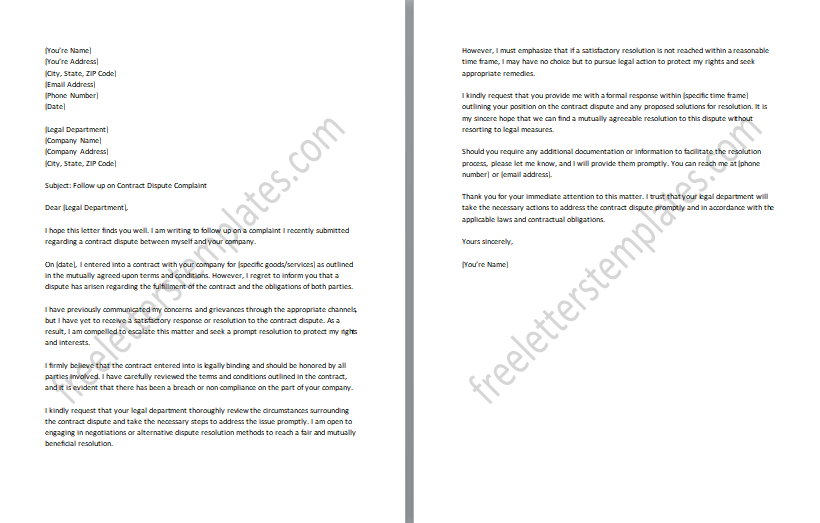
#9: Employee Behavior Complaint Follow-up Letter:
This letter is used to follow up on a complaint about unprofessional behavior or misconduct by an employee, requesting appropriate action from the employer. The Employee Behavior Complaint Follow-up Letter is a way for individuals to address their concerns regarding unprofessional behavior or misconduct exhibited by an employee and request appropriate action from the employer. It provides an opportunity for the individual to reiterate the details of the incident, including the specific behavior observed and any negative impact it had. The letter also highlights the individual’s expectation for a timely and effective resolution to the employee behavior complaint, fostering a positive and conducive workplace atmosphere.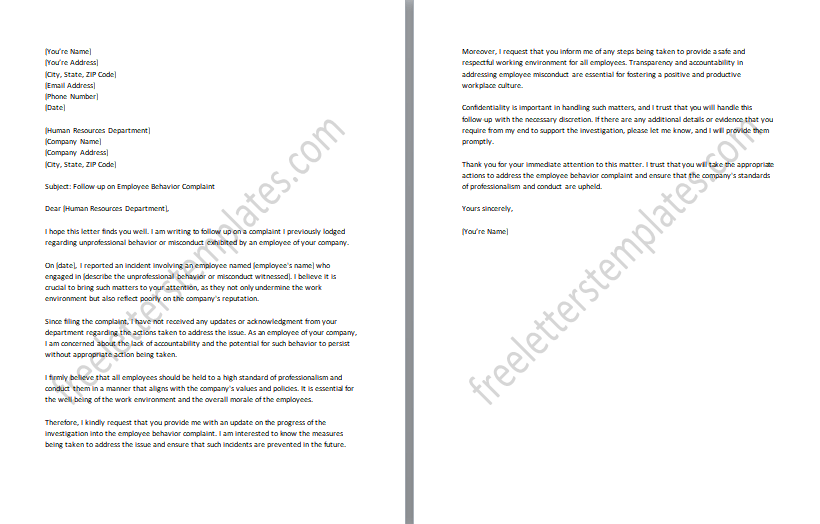
#10: Insurance Claim Complaint Follow-up Letter:
This letter is sent to follow up on a complaint about an insurance claim that has been denied or inadequately processed, seeking a review and resolution. The Insurance Claim Complaint Follow-up Letter is a means to express dissatisfaction with a denied or inadequately processed insurance claim and request a review and resolution. It serves as a follow-up to a previous complaint, reiterating the claim details and emphasizing the need for a fair reconsideration. The letter aims to establish effective communication and seeks a prompt resolution that aligns with the terms of the insurance policy.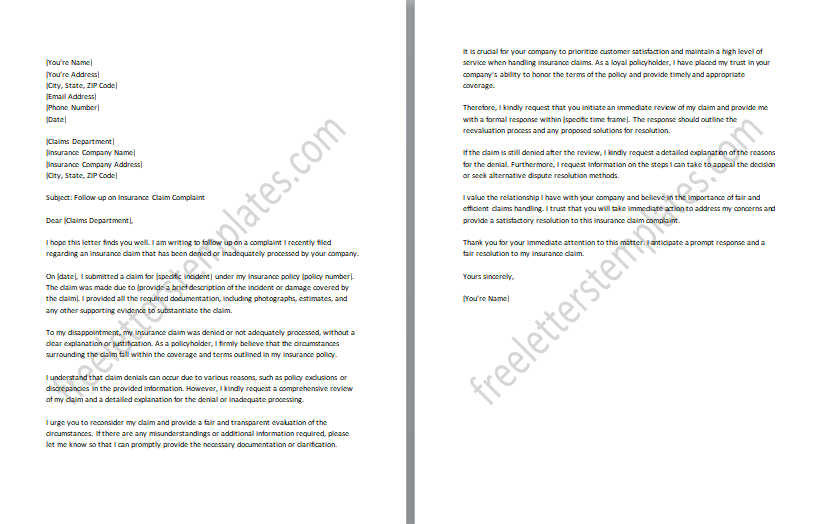
#11: Misrepresentation Complaint Follow-up Letter:
This letter is used to follow up on a complaint regarding misrepresentation of facts, products, or services, demanding corrective measures. The Misrepresentation Complaint Follow-up Letter is a means for individuals to address their complaint regarding the misrepresentation of facts, products, or services and demand corrective measures. It serves as a follow-up to a previous complaint, reasserting the concerns raised and the impact of the misrepresentation. The letter aims to emphasize the importance of truthful and accurate information, urging the recipient to take immediate corrective actions. Its purpose is to seek transparency, accountability, and a resolution that rectifies the misrepresentation and prevents similar occurrences in the future.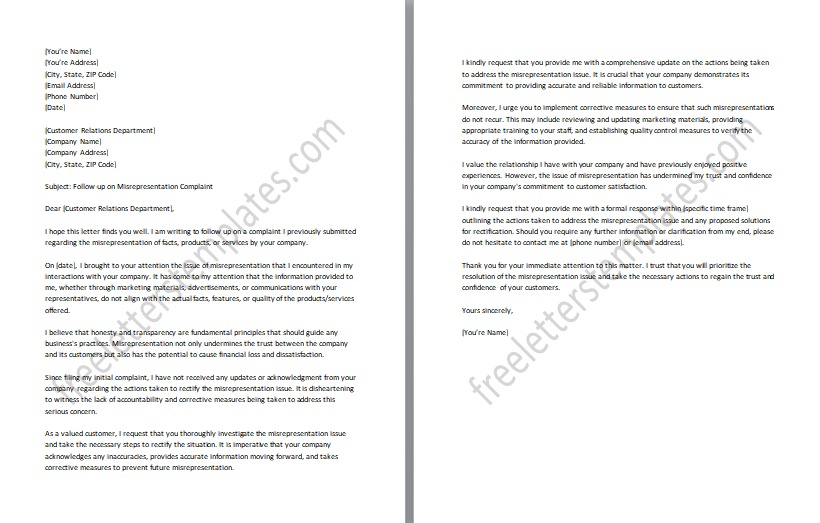
#12: Technical Support Complaint Follow-up Letter:
This letter is sent to follow up on a complaint about unsatisfactory technical support or assistance received, requesting further assistance or escalation. The Technical Support Complaint Follow-up Letter is a means for individuals to address their dissatisfaction with unsatisfactory technical support or assistance received and request further assistance or escalation. It serves as a follow-up to a previous complaint, reiterating the details of the technical issue and expressing the impact of the inadequate support received. The letter aims to emphasize the importance of reliable technical support and the need for a prompt resolution. It requests the recipient to provide further assistance, clarify any unresolved issues, or escalate the matter to higher-level support if necessary.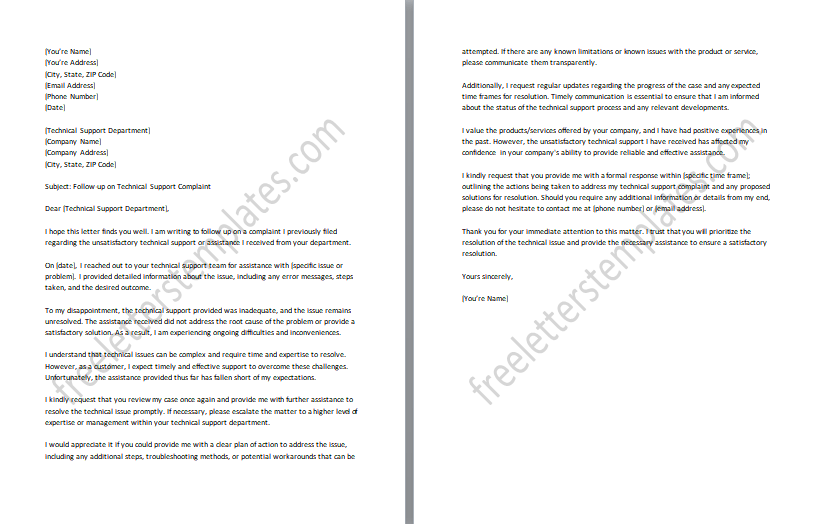
#13: Pricing Discrepancy Complaint Follow-up Letter:
This letter is used to follow up on a complaint about a pricing discrepancy, seeking clarification, adjustment, or refund. The Pricing Discrepancy Complaint Follow-up Letter is a means for individuals to address their complaint regarding a pricing discrepancy and seek clarification, adjustment, or refund. It serves as a follow-up to a previous complaint, restating the details of the pricing issue and expressing the need for resolution. The letter emphasizes the importance of accurate and transparent pricing, requesting the recipient to provide clarification on the discrepancy, make necessary adjustments, or issue a refund if applicable.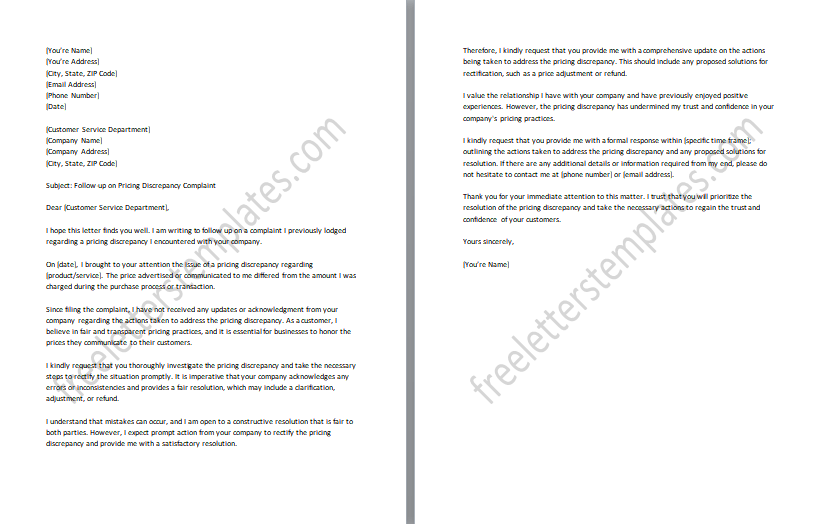
#14: Unsatisfactory Service Complaint Follow-up Letter:
This letter is sent to follow up on a complaint about unsatisfactory service experienced, requesting a resolution or compensation. The Unsatisfactory Service Complaint Follow-up Letter is a means for individuals to address their complaints about unsatisfactory service experience and request a resolution or compensation. It serves as a follow-up to a previous complaint, restating the details of the service issue and expressing the disappointment and inconvenience caused. The letter emphasizes the importance of providing quality service to customers and seeks a fair and satisfactory resolution to the matter. It requests the recipient to take appropriate actions to address the service deficiency and may also mention the expectation of compensation, if applicable.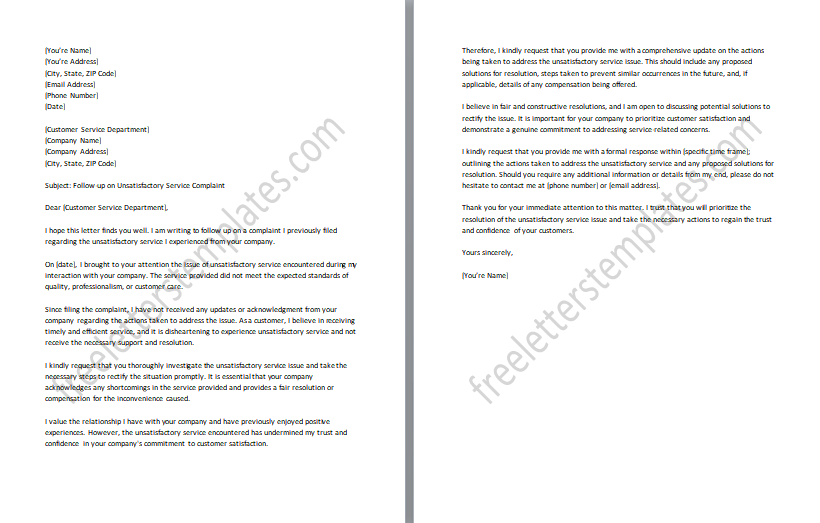
#15: Website Malfunction Complaint Follow-up Letter:
This letter is used to follow up on a complaint about a website malfunction or error, urging the company to rectify the issue. The Website Malfunction Complaint Follow-up Letter is a means to address a complaint about a website malfunction or error and urge the company to rectify the issue. It serves as a follow-up, restating the details of the malfunction and expressing the inconvenience caused. The letter emphasizes the importance of a functional website, requesting immediate action to resolve the issue. Its purpose is to establish effective communication, convey the urgency of the situation, and work toward a prompt resolution.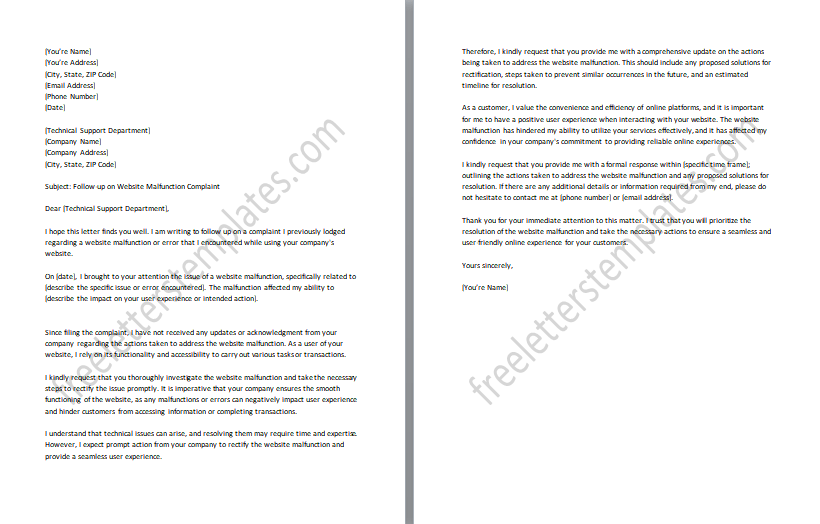
#16: Lost Package Complaint Follow-up Letter:
This letter is sent to follow up on a complaint about a lost or missing package, seeking investigation and resolution. The Lost Package Complaint Follow-up Letter is a means to address a complaint about a lost or missing package and seek investigation and resolution. It serves as a follow-up, restating the details of the issue and expressing the frustration caused. The letter emphasizes the importance of resolving the matter promptly and requests a thorough investigation. Its purpose is to establish effective communication and work towards locating the lost package or providing appropriate compensation.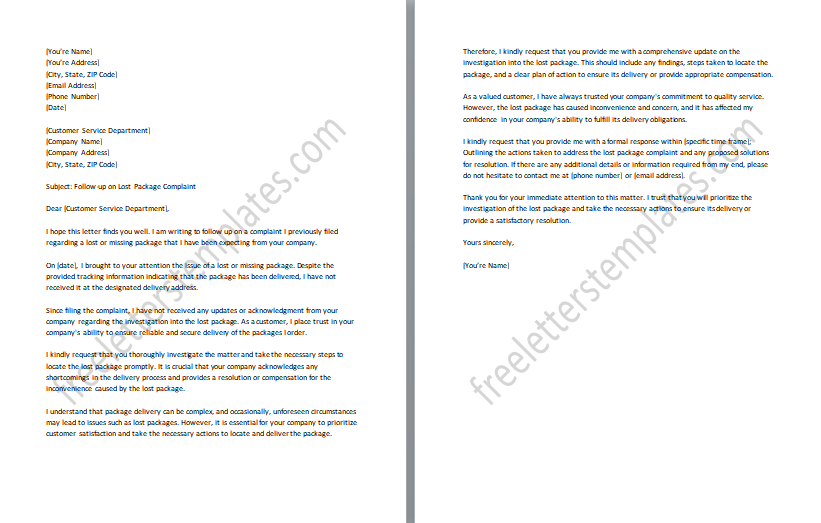
#17: Shipping Damage Complaint Follow-up Letter:
This letter is used to follow up on a complaint regarding damaged goods received during shipping, requesting replacement or reimbursement. The Shipping Damage Complaint Follow-up Letter is a means to address a complaint about damaged goods received during shipping and request replacement or reimbursement. It serves as a follow-up, restating the details of the damage and expressing dissatisfaction with the received products. The letter emphasizes the importance of proper handling and packaging during shipping, requesting the recipient take responsibility for the damage. It seeks a resolution by requesting either replacement of the damaged goods or reimbursement for the value of the damaged items. Its purpose is to establish effective communication, convey the need for a fair resolution, and ensure that the shipping damage complaint is appropriately addressed.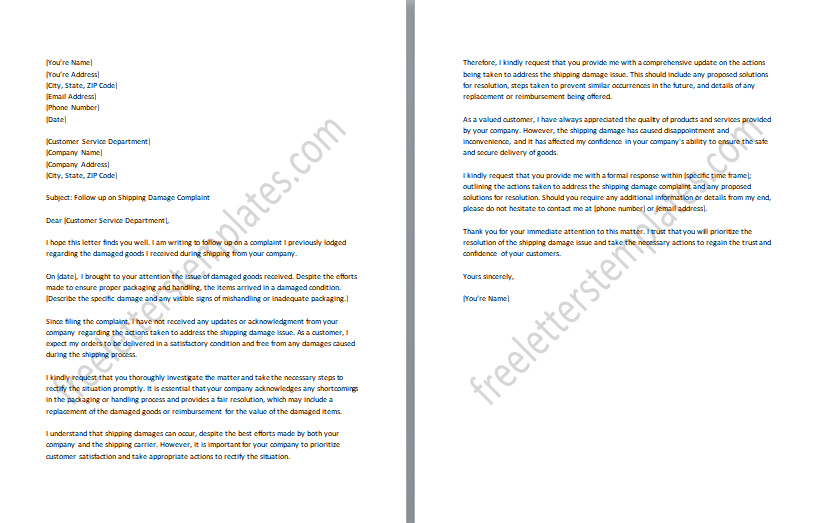
#18: Rude Customer Service Complaint Follow-up Letter:
This letter is sent to follow up on a complaint about rude or disrespectful behavior from customer service representatives, seeking an apology and assurance of improved service. The Rude Customer Service Complaint Follow-up Letter is a means for individuals to address their complaints about rude or disrespectful behavior from customer service representatives and seek an apology and assurance of improved service. It serves as a follow-up to a previous complaint, restating the details of the unpleasant customer service experience and expressing the impact it had on the individual. Its purpose is to establish effective communication, express the expectation of better treatment, and work towards a resolution that ensures improved customer service experiences in the future.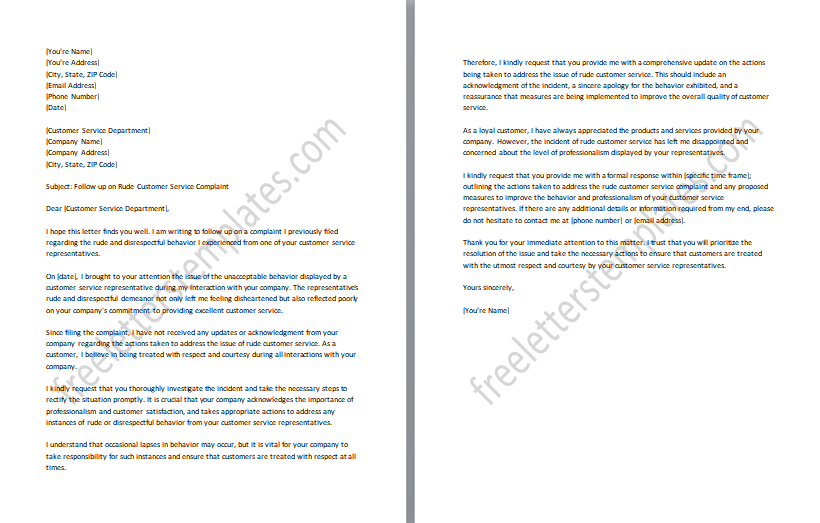
#19: Product Recall Complaint Follow-up Letter:
This letter is used to follow up on a complaint about a product that was subject to a recall, requesting information, replacement, or refund. The Product Recall Complaint Follow-up Letter is a means for individuals to address their complaint about a product that was subject to a recall and request information, replacement, or refund. It serves as a follow-up, restating the details of the recalled product and expressing the concern and inconvenience caused. The letter emphasizes the importance of consumer safety and seeks clarification on the recall process, as well as the options available for replacement or refund. Its purpose is to establish effective communication, seek resolution regarding the recalled product, and ensure that appropriate actions are taken to address the issue and provide a satisfactory resolution to the customer.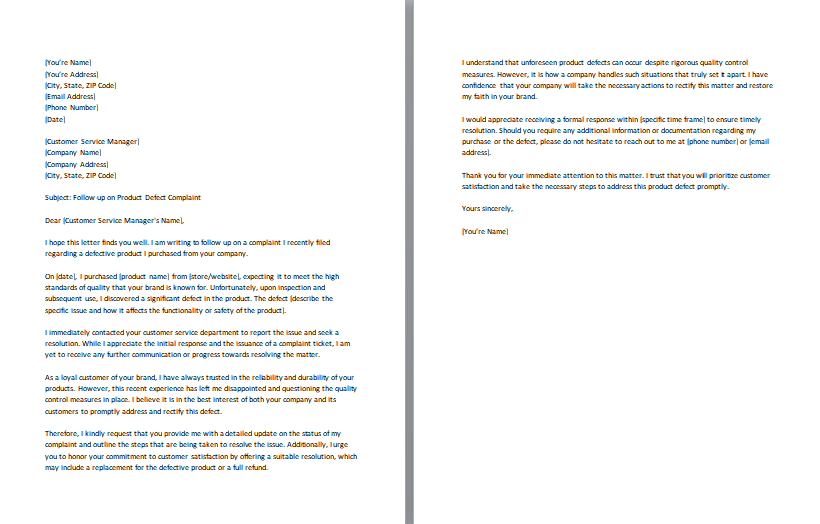
#20: Unsolicited Marketing Complaint Follow-up Letter:
This letter is sent to follow up on a complaint about unsolicited marketing communications, requesting removal from the mailing list and assurance of compliance with privacy regulations. The Unsolicited Marketing Complaint Follow-up Letter is a means for individuals to address their complaint about receiving unsolicited marketing communications and request removal from the mailing list, as well as the assurance of compliance with privacy regulations. The letter emphasizes the importance of respecting customer preferences and privacy rights, requesting the recipient to promptly remove the individual’s contact information from their mailing list. It also seeks assurance that the company will comply with privacy regulations to prevent future unsolicited communications.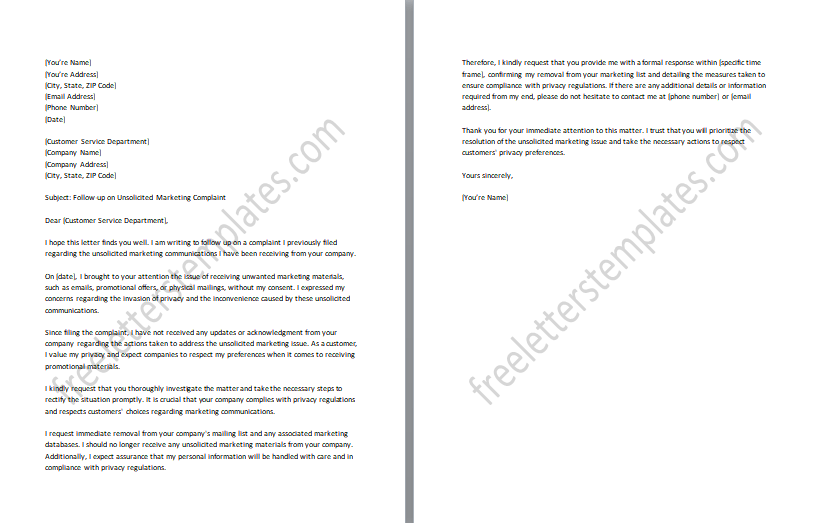
Common Mistakes to Avoid
- Being overly emotional: While it’s natural to feel frustrated or upset about the issue, it’s important to maintain a calm and professional tone in your letter. Avoid writing in an overly emotional or angry manner, as it may hinder effective communication and resolution. Take a step back, breathe, and approach the letter with a composed mindset.
- Lack of clarity and specificity: One common mistake is not clearly stating the issue or providing enough specific details. Ensure that you clearly explain the problem, including dates, names, and any relevant order or account numbers. Be precise in describing what went wrong to help the recipient understand the situation fully.
- Neglecting to mention previous communication: If you have already made an initial complaint or had previous correspondence regarding the issue, it’s important to reference it in your follow-up letter. This helps the recipient connect the dots and ensures that your concerns are addressed in the proper context.
- Failing to state a desired resolution: It’s essential to clearly state what you expect as a resolution to your complaint. Avoid being vague or leaving it up to the recipient to guess what you want. Clearly articulate your desired outcome, whether it’s a refund, replacement, apology, or specific action to rectify the situation.
- Writing a lengthy or rambling letter: Keep your complaint follow-up letter concise, focused, and to the point. Avoid unnecessary rambling or including unrelated information. Stick to the key details and issues that directly pertain to your complaint. A well-structured and succinct letter is more likely to grab the recipient’s attention and lead to a prompt response.
- Neglecting to provide supporting evidence: If you have any supporting documents, such as receipts, invoices, or photographs, that strengthen your case or validate your complaint, be sure to include copies with your letter. This helps provide concrete evidence to support your claims and gives weight to your complaint.
- Failing to set a reasonable deadline: While it’s important to request a timely response, it’s equally important to set a reasonable deadline for the recipient to address your concerns. Avoid setting unrealistic or overly short deadlines, as it may hinder the resolution process. Give the recipient a reasonable amount of time to investigate and respond to your complaint.
Concluding Thoughts
In conclusion, effective complaint follow-up is a vital component of the resolution process. It allows you to address customer concerns, maintain open lines of communication, and demonstrate your commitment to customer satisfaction. By utilizing well-crafted follow-up letters, staying proactive, and offering timely updates, you can navigate the complaint resolution journey with confidence. Remember, each follow-up is an opportunity to showcase your dedication to resolving issues, building trust, and leaving a positive impression on your customers. Embrace the power of follow-up, and empower yourself to transform complaints into opportunities for growth, improvement, and strengthened customer relationships.